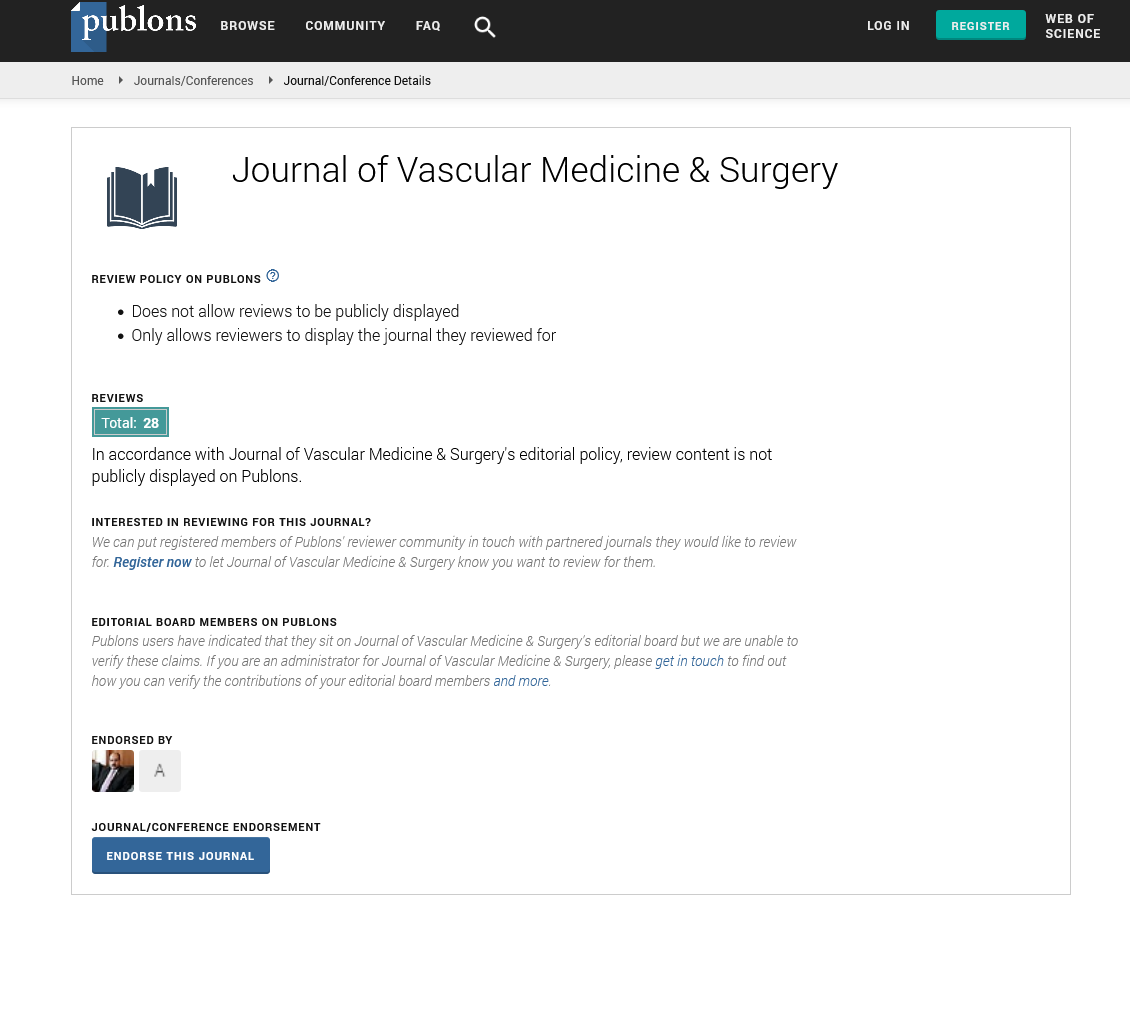Indexed In
- Open J Gate
- Academic Keys
- RefSeek
- Hamdard University
- EBSCO A-Z
- OCLC- WorldCat
- Publons
- Euro Pub
- Google Scholar
- SHERPA ROMEO
Useful Links
Share This Page
Journal Flyer

Open Access Journals
- Agri and Aquaculture
- Biochemistry
- Bioinformatics & Systems Biology
- Business & Management
- Chemistry
- Clinical Sciences
- Engineering
- Food & Nutrition
- General Science
- Genetics & Molecular Biology
- Immunology & Microbiology
- Medical Sciences
- Neuroscience & Psychology
- Nursing & Health Care
- Pharmaceutical Sciences
Opinion Article - (2024) Volume 0, Issue 0
Arterial Thrombosis: Causes, Symptoms, Diagnosis and Treatment
Gangl Clemens*Received: 25-Nov-2024, Manuscript No. JVMS-24-27720; Editor assigned: 27-Nov-2024, Pre QC No. JVMS-24-27720 (PQ); Reviewed: 11-Dec-2024, QC No. JVMS-24-27720; Revised: 18-Dec-2024, Manuscript No. JVMS-24-27720 (R); Published: 27-Dec-2024, DOI: 10.35248/2329-6925.24.S25.562
Description
Arterial thrombosis is a medical disorder that occurs when a blood clot or thrombus forms in an artery, preventing the circulation of oxygen-rich blood to the essential organs. This condition can lead to severe and life-threatening outcomes, including heart attacks, strokes and Peripheral Arterial Disease (PAD).
Causes of arterial thrombosis
The formation of blood clots in arteries is primarily driven by damage to the arterial walls, which can increase the body’s clotting mechanism. Significant causes include.
Atherosclerosis: The accumulation of fatty deposits (plaques) in the arterial walls narrows the arteries, consequently susceptible to injury and thrombosis development. Plaque rupture can demonstrate the inner layers of the artery, obtaining platelets and leading to clot development.
Chronic inflammation: Conditions such as rheumatoid arthritis, lupus and other inflammatory diseases can cause chronic damage to blood vessels, increasing the risk of arterial thrombosis.
Injury or trauma: Direct injury to an artery, for example, during surgery or due to an acute trauma, can result in clot formation.
Infections: Severe infections that damage blood vessels may increase the probability of clot formation.
Genetic factors: Inherited conditions such as factor V Leiden mutation or deficiencies in natural anticoagulants (e.g., protein C or protein S) can contribute individuals to thrombosis.
Risk factors for arterial thrombosis
Arterial thrombosis frequently develops in individuals with associated risk factors. These include: Older adults are more susceptible due to the chronic effects of vascular damage. Tobacco use damages arterial walls and develops plaque buildup. Hypertension (high blood pressure) elevated blood pressure transmits increased stress on vasculature, increasing the risk of damage. Increased levels of Low-Density Lipoprotein (LDL) cholesterol can result in plaque development. Diabetes accelerates atherosclerosis and damages small and large blood vessels. Excess weight is associated with increased inflammation and higher cholesterol levels, which contribute to arterial damage. Physical inactivity facilitates poor circulation and may increase the risk of clot formation. Chronic stress can elevate blood pressure and contribute to arterial damage continuously.
Complications of arterial thrombosis
Arterial thrombosis can lead to life-threatening complications, including.
Acute limb ischemia: Sudden preventing of blood flow to a limb can cause tissue death, necessitating amputation.
Heart attack: Complete blockage of a coronary artery eliminates the heart muscle of oxygen, potentially causing permanent damage or death.
Ischemic stroke: Blockage of blood flow to the brain can result in lasting neurological deficits or death.
Organ damage: Arterial clots in organs including the kidneys or intestines can lead to loss of organ function.
Prevention of arterial thrombosis
Preventive techniques are essential, especially for individuals with risk factors. Significant measures include.
Managing risk factors: Regular monitoring and control of blood pressure, cholesterol and blood sugar levels. Using prescription medications to treat certain risk factors, such as antihypertensive or lipids.
Healthy lifestyle choices: Maintaining a healthy weight and avoiding processed foods high in trans fats and sodium.
Medical interventions for high-risk individuals: Prophylactic use of antiplatelet drugs or anticoagulants for those at high risk.
Regular screening for arterial blockages in individuals with a family history of cardiovascular disease.
Treatment of arterial thrombosis
Treatment techniques for arterial thrombosis focus on restoring blood flow, preventing further clot formation and managing underlying causes. Common methods include: Aspirin and clopidogrel prevent platelets from accumulation collectively, which reduces the chance of clot formation. Drugs such as heparin or warfarin may be used to prevent further clot growth. Alteplase and tenecteplase are medications that dissolve clots in medical emergencies including a heart attack or stroke. A catheter is utilized to clear the blocked artery, while a coronary artery is used to maintain it easily accessible. Surgical removal of plaque from an artery commonly performed in carotid arteries.
Citation: Clemens G (2024). Arterial Thrombosis: Causes, Symptoms, Diagnosis and Treatment. J Vasc Surg. S25:562.
Copyright: © 2024 Clemens G. This is an open access article distributed under the terms of the Creative Commons Attribution License, which permits unrestricted use, distribution and reproduction in any medium, provided the original author and source are credited.

